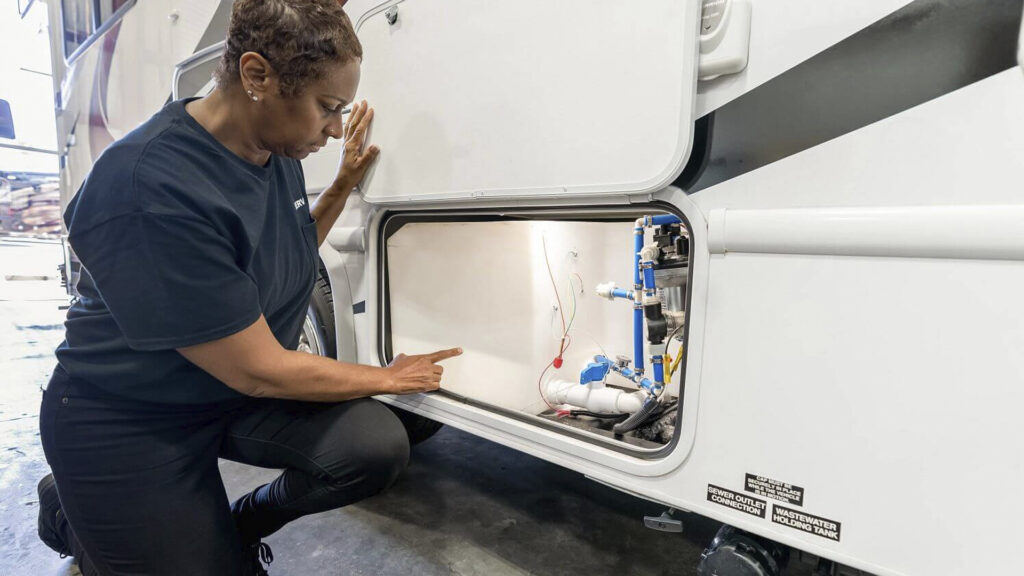
The Ultimate Guide: How to Fill RV Water Tank
Table of contents
- Understanding Your RV’s Fresh Water System
- Essential Supplies for Filling Your RV Water Tank
- Step-by-Step Guide to Filling Your RV Fresh Water Tank
- Alternative Methods for Filling Your RV Water Tank
- Hooking Up to City Water
- Maintaining Water Quality and Tank Hygiene
- Troubleshooting Common Water System Issues
- Shield Your RV from Winter – Protect Your Water System with Custom Skirting!
A properly filled RV water tank is essential for any enjoyable camping trip, providing a convenient supply of clean water for cooking, cleaning, and personal hygiene. Knowing how to fill your RV water tank correctly ensures that your water stays fresh, helping you avoid issues with pressure or contaminants. This guide will cover everything you need to know about how to fill your RV water tank, how to fill the fresh water tank on your RV, and essential supplies for safe, efficient filling.
Understanding Your RV’s Fresh Water System
Before diving into the steps of how to fill your RV water tank, it’s essential to understand the components of your RV’s fresh water system. Generally, the fresh water system includes:
- Fresh Water Tank: The primary storage container for your water, typically located under your RV’s flooring or in a compartment. This tank holds water for all your RV’s sinks, shower, and toilet.
- Water Pump: This pump draws water from your fresh water tank and pushes it to the faucets and shower. It’s usually controlled by a switch near the main control panel.
- City Water Connection: An external inlet allowing you to hook up directly to a pressurized water source, bypassing the need to fill the fresh water tank on your RV.
In newer RVs, the fresh water fill point is usually marked clearly, but in used or customized RVs, the label might be missing. Ensure you locate the correct fill point to avoid accidental connections or overflows.
Essential Supplies for Filling Your RV Water Tank
Proper equipment is essential for filling your RV water tank effectively and safely. Here are the key supplies you’ll need:
- Potable Water Hose: Unlike standard garden hoses, a potable water hose is designed for drinking water and won’t leach harmful chemicals or odors into your fresh water tank. Opt for a BPA-free, NSF-certified potable water hose for the best results.
- Water Filter: If your RV lacks an onboard filtration system, an external water filter can help remove contaminants, sediment, and odd flavors from your water. This step can be crucial, especially if the water source quality is questionable.
- Water Pressure Regulator: This device controls the pressure of the water entering your RV, protecting the plumbing system from surges that could cause leaks or bursts.
Having these items on hand will make the process of how to fill the fresh water tank on your RV much simpler and safer.
Step-by-Step Guide to Filling Your RV Fresh Water Tank

Follow these detailed steps to properly fill your RV fresh water tank:
1. Locating the Fresh Water Fill Point
Locate the fresh water fill point on your RV. This is usually labeled, but if it’s not, consult your RV’s manual or do a quick walkthrough. The fresh water fill is often a capped inlet located on the exterior of the RV.
2. Connecting the Potable Water Hose
Attach the potable water hose to the fill point. It’s crucial to use a hose specifically rated for drinking water to avoid any contamination in your fresh water supply.
3. Using a Water Filter (If Applicable)
Attach an inline water filter to the end of the potable water hose, if available. This filter will remove impurities and improve the taste and safety of your water.
4. Monitoring the Filling Process
Turn on the water source and let the tank fill. Keep an eye on the process to ensure there’s no overflow. Some RVs have a clear tube or a sensor to show the water level, but if yours doesn’t, listen for a change in sound that indicates the tank is nearing full.
5. Knowing When the Tank is Full
Once the tank is full, the water should either flow out of an overflow valve or the sound will shift. Avoid overfilling, as it can create undue pressure on your tank and plumbing system.
6. Proper Disconnection and Storage of Equipment
Once filled, turn off the water source and disconnect the potable water hose. Store the hose, filter, and regulator in a clean, dry location to keep them free from dirt or bacteria.
Alternative Methods for Filling Your RV Water Tank
In certain situations, you might not have access to a city water connection or a dedicated RV fill station. Here are some alternative methods to consider:
1. Using Gravity Fill with Portable Water Containers
Gravity fill allows you to pour water from portable containers into your RV’s fresh water tank. This method works well when you’re in remote locations, but it can be labor-intensive, especially if you need a large quantity of water.
2. Utilizing Water Transfer Pumps
A water transfer pump allows you to move water from a container or natural source to your fresh water tank. Pumps are often portable and powered by batteries, making them ideal for off-grid scenarios.
3. Collecting and Filtering Rainwater (As a Last Resort)
While not ideal, rainwater collection is possible if you have a filtration system to purify the water. This method is usually considered a last resort for emergencies.
Hooking Up to City Water

If your campground or RV park has a city water hookup, you can connect your potable water hose directly to it. This connection bypasses the need to fill your RV water tank, as it provides a steady supply. Always use a water pressure regulator when hooking up to city water to prevent damage to your plumbing.
Maintaining Water Quality and Tank Hygiene
To keep your fresh water tank in optimal condition, regular maintenance is necessary. Here are some best practices:
Sanitizing the Fresh Water System
At least every six months, sanitize your fresh water system by flushing it with a bleach solution to eliminate bacteria or mold. Rinse thoroughly to remove any bleach residue.
Frequency of Tank Cleaning
Clean your tank whenever the RV has been in storage or has not been used for several weeks. This prevents any buildup of bacteria or debris that could affect water quality.
Using Water Treatment Products
Consider using water treatment drops or tablets for added sanitation. These products can help reduce bacteria levels and preserve the taste of the water.
Winterizing the Water System
In colder climates, winterize your system to prevent pipes and tanks from freezing. Drain all water and add RV antifreeze if needed. Always follow the guidelines of the NFPA 1192 standard, which ensures safe RV water system practices.
Troubleshooting Common Water System Issues
Even with proper maintenance, issues can arise in your RV water system. Here’s a quick troubleshooting guide:
No Water Flow from Faucets
If there’s no water flow, check if the water pump is turned on and functioning correctly. Inspect for any blockages in the hose or tank outlet.
Low Water Pressure
Low pressure can result from low tank levels or a clogged filter. Refill the tank, clean or replace the filter, and check your water pump.
Strange Tastes or Odors in the Water
If the water has an unusual taste or smell, it might be time to clean and sanitize the fresh water tank. Using a high-quality water filter can also help remove unpleasant flavors.
Leaks in the Water System
Leaks are often due to loose connections or damaged hoses. Inspect all connections, hoses, and fittings, tightening or replacing them as necessary.
Knowing how to fill your RV water tank properly gives you peace of mind and ensures a steady supply of clean, fresh water for your adventures. Whether you’re using city water, alternative methods, or simply maintaining your fresh water tank’s hygiene, following these steps and tips will help you enjoy your RV experience without any water-related issues.
Shield Your RV from Winter – Protect Your Water System with Custom Skirting!
Keep your RV water system running smoothly all year long! With custom RV skirting, you’ll shield your pipes from freezing temperatures, block out snow and wind, and add a layer of insulation for your entire rig. Our top-rated “No-Snap, No-Gap” channel system fits flawlessly to protect your RV in the coldest climates, tested across North America for over a decade. Ready to hit the road without worry? Get the nation’s best custom skirting today, and secure your RV for every season’s adventure!
